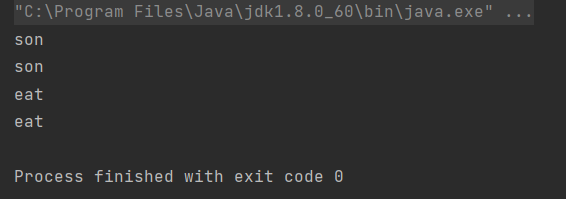多态和类型转换
1、多态是方法的多态,属性没有多态。
2、父类与子类,有联系,类型转换异常。
3、存在条件:继承关系, 方法需要重写,父类引用指向子类对象。
例子:
1 public class Polymorphism { 2 public static void main(String[] args) { 3 4 //Student2能调用的方法都是自己的或者继承父类的 5 Student2 s1 = new Student2(); 6 //父类的引用指向子类 7 //Person2父类型, 可以指向子类,但是不能调用子类独有的方法 8 Person2 s2 = new Student2(); 9 10 s1.run(); 11 s2.run(); 12 13 s1.eat(); 14 //对象能执行哪些方法,主要看对象左边的类型,和右边关系不大 15 //子类重写了父类方法,执行子类的方法 16 ((Student2)s2).eat(); 17 } 18 } 19 class Person2 { 20 public void run() { 21 System.out.println("run"); 22 } 23 } 24 class Student2 extends Person2{ 25 @Override 26 public void run() { 27 System.out.println("son"); 28 } 29 public void eat(){ 30 System.out.println("eat"); 31 } 32 33 }

类型转换
1、父类引用指向子类的对象。
2、把子类转换为父类,向上转换。
3、把父类转换为子类,向下转换,强制转换。
4、方便方法的调用,减少重复的代码!简洁
例子:
1 public class Convert { 2 public static void main(String[] args) { 3 //类型之间的转换 4 Person3 obj = new Student3(); 5 //obj将这个对象转换为Student3类型, 我们就可以使用Student3类型的方法了! 6 //强制转换, 高转低! 7 //或者我们可以使用一句来代替两句: ((Student3)obj).go(); 8 Student3 obj1 = (Student3) obj; 9 obj1.go(); 10 11 //子类转化为父类,可能丢失自己本来的一些方法! 12 Student3 student3 = new Student3(); 13 student3.run(); 14 //转换为Person3类型,低转高,自动转 15 Person3 person3 = student3; 16 } 17 18 } 19 class Person3{ 20 21 } 22 23 class Student3 extends Person3{ 24 public void go(){ 25 System.out.println("go"); 26 } 27 28 public void run(){ 29 System.out.println("run"); 30 } 31 32 }




 浙公网安备 33010602011771号
浙公网安备 33010602011771号